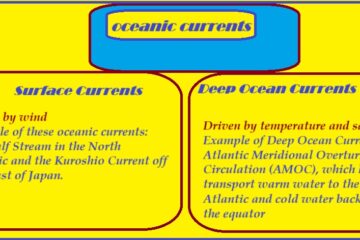Oceanic Currents in Different Oceans
Oceanic Currents in Different Oceans
Here’s an overview of the major oceanic currents in different oceans:
Atlantic Ocean Currents
The Atlantic Ocean has several important currents, most of which are part of the Atlantic Meridional Overturning Circulation (AMOC) system.
- Gulf Stream: One of the most well-known currents, the Gulf Stream is a warm ocean current that flows from the Gulf of Mexico, up the eastern coast of the United States, and then crosses the Atlantic towards Europe. It moderates the climate of Western Europe, keeping it much warmer than other regions at similar latitudes.
- North Atlantic Drift: This is an extension of the Gulf Stream, flowing eastward across the North Atlantic Ocean, bringing warm water to the northern parts of Europe.
- Canary Current: A cold current that flows southward along the coast of North Africa, coming from the North Atlantic subtropical gyre.
- Equatorial Currents: These include the North and South Equatorial Currents, which move westward near the equator. These currents are driven by the trade winds.
- Labrador Current: A cold current that flows southward from the Arctic Ocean along the coast of Labrador and Newfoundland in Canada.
Pacific Ocean Currents
The Pacific Ocean is the largest ocean, and its currents are influenced by the El Niño-Southern Oscillation (ENSO) and the Pacific Decadal Oscillation (PDO).
- Kuroshio Current: Also known as the Japan Current, it is a warm ocean current that flows northward along the eastern coast of Japan. It is similar to the Gulf Stream in the Atlantic.
- California Current: A cold current that flows southward along the coast of the western United States. This is part of the North Pacific subtropical gyre.
- Equatorial Currents: Similar to the Atlantic, the Pacific has both North and South Equatorial Currents that flow westward, driven by the trade winds.
- Peru (Humboldt) Current: A cold, nutrient-rich current that flows northward along the western coast of South America, influencing the climate and productivity of the region.
- Oyashio Current: A cold current that flows southward from the Arctic Ocean and joins the Kuroshio Current in the North Pacific, contributing to the upwelling off the coast of Japan.
- Subtropical Gyre: The Pacific Subtropical Gyre is a large circular system of currents, including the North Pacific Current, the Kuroshio, and the California Current.
Indian Ocean Currents
The Indian Ocean has a more complex system of currents, largely influenced by monsoons and the seasonal reversal of wind patterns.
- Agulhas Current: A warm, fast-moving current that flows down the eastern coast of Africa from the equator towards the southern tip of the continent. It plays a significant role in the exchange of water between the Indian and Atlantic Oceans.
- Equatorial Currents: Similar to other oceans, there are both North and South Equatorial Currents in the Indian Ocean, moving westward across the ocean.
- Somali Current: A current that reverses direction based on the monsoon seasons. During the summer monsoon, it flows southwestward, and during the winter monsoon, it flows northeastward.
- Leeuwin Current: A warm current that flows southward along the coast of Western Australia, playing an important role in the oceanography of the region.
Southern Ocean Currents
The Southern Ocean, which encircles Antarctica, is unique in its circulation patterns.
- Antarctic Circumpolar Current (ACC): This is the world’s largest and strongest ocean current. It flows around Antarctica, connecting the Atlantic, Pacific, and Indian Oceans. It’s driven by westerly winds and is critical for global ocean circulation and the climate system.
- West Wind Drift: A part of the ACC, this current flows from west to east around Antarctica.
Arctic Ocean Currents
The currents in the Arctic Ocean are influenced by the polar environment, ice cover, and freshwater inputs.
- Transpolar Drift: This current flows from the Siberian coast across the Arctic Ocean towards Greenland and the Atlantic. It plays a role in the movement of sea ice in the region.
- East Greenland Current: A cold current flowing southward along the coast of Greenland, transporting ice and cold water.
| Oceanic Currents in Different Oceans | |
| Name of Ocean | Currents |
| Atlantic Ocean | Gulf Stream, North Atlantic Drift, Canary Current, Equatorial Currents, Labrador Current |
| Pacific Ocean | Kuroshio Current, California Current, Equatorial Currents, Peru (Humboldt) Current, Oyashio Current, Subtropical Gyre |
| Indian Ocean | Agulhas Current, Equatorial Currents, Somali Current, Leeuwin Current |
| Southern Ocean | Antarctic Circumpolar Current (ACC), West Wind Drift |
| Arctic Ocean | Transpolar Drift, East Greenland Current |
You can also read:
- Suez Canal
- List of Important Glaciers of Himalayan Mountain
- List of main volcanoes in the world
- List of Mountain Passes of India
- Indus river system
- Ganga river system
Thank you



0 Comments